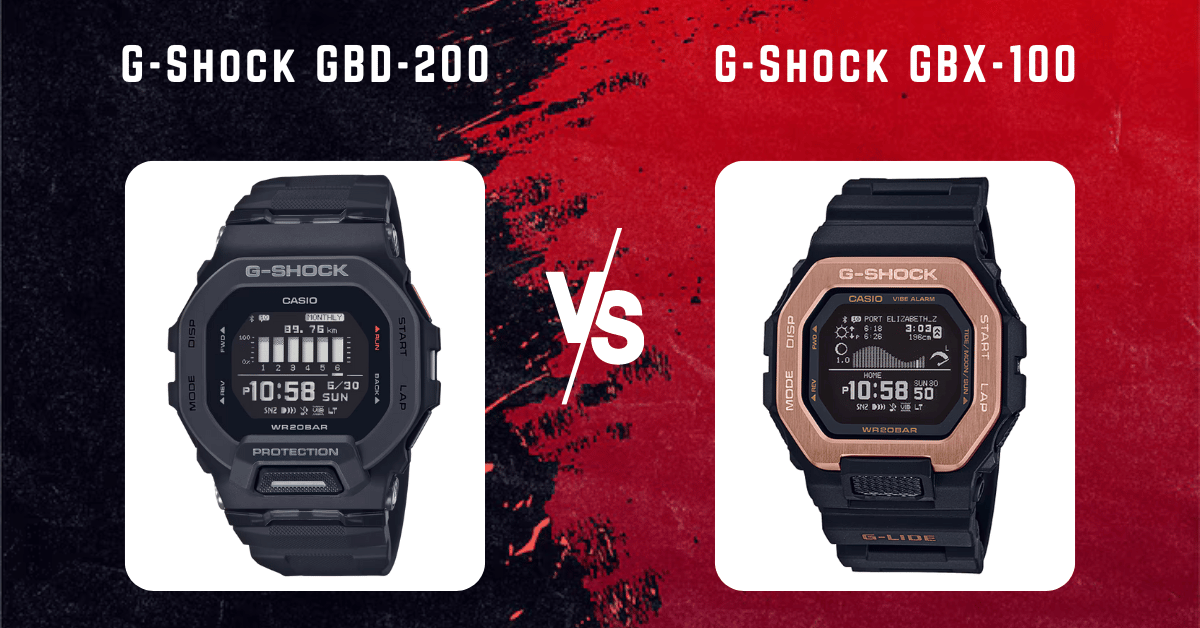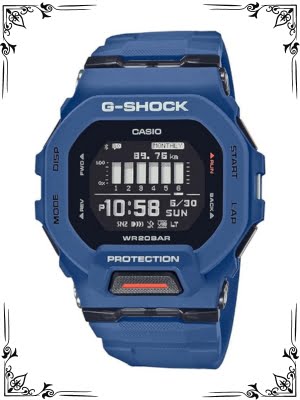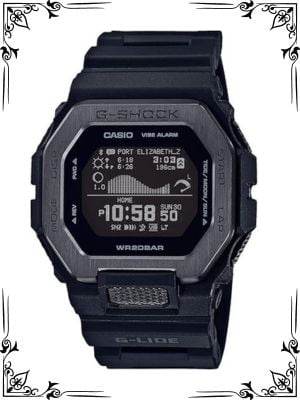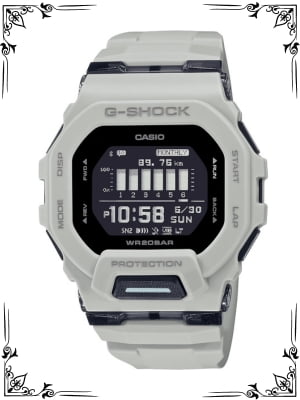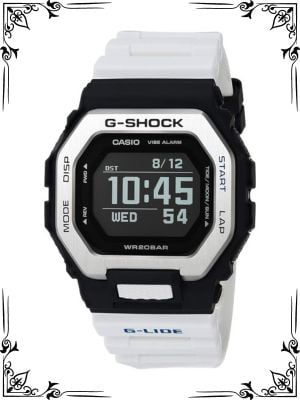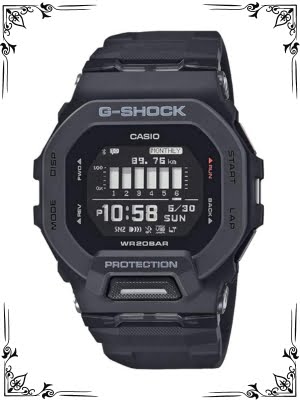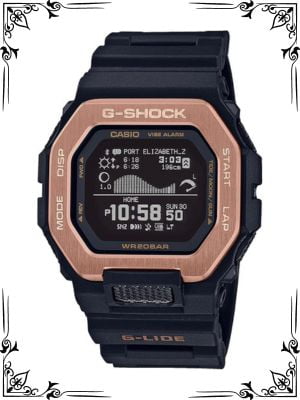The GBD-200 is a land-focused fitness tracker that excels in step counting, distance tracking, and daily activity monitoring. The GBX-100, however, is a multisport tracker, thriving in both land and water environments. It offers features like tide graphs, moon phases, and training modes suitable for surfers, swimmers, and outdoor adventurers.
Introduction
In the realm of G-Shock watches, two titans rise to the challenge of fitness tracking: the GBD-200 and the GBX-100. Both boast impressive durability and comprehensive features but cater to slightly different fitness enthusiasts.
This detailed guide will dissect their functionalities, design elements, and user feedback to help you choose the G-Shock that perfectly complements your active lifestyle.
A Blast from the Past: A Look at G-Shock’s Legacy
Before diving into the specifics, let’s appreciate the shared heritage. Since 1983, G-Shock has been synonymous with toughness and functionality. Both the GBD-200 and GBX-100 carry this legacy forward, offering cutting-edge features housed within a G-Shock’s legendary durability.
Technical Breakdown: Unveiling the Inner Workings
Here’s a table outlining the key technical specifications of each watch:
| Feature | GBD-200 | GBX-100 |
|---|---|---|
| Movement | Quartz (battery-powered) | Quartz (battery-powered) |
| Battery Life | Up to 2 years (CR1220 battery) | Up to 2 years (CR1220 battery) |
| Timekeeping | Digital and analog hands | Digital and analog hands |
| World Time | Yes | Yes |
| Stopwatch | Yes (up to 1/100th of a second) | Yes (up to 1/100th of a second) |
| Countdown Timer | Yes (up to 24 hours) | Yes (up to 24 hours) |
| Alarm | Yes (with snooze) | Yes (with snooze) |
| Illumination | LED backlight | LED backlight |
| Water Resistance | 200 meters (20 bar) | 200 meters (20 bar) |
| Bluetooth Connectivity | Yes | Yes |
| Mobile App Integration | Yes (via the G-Shock Connected app) | Yes (via G-Shock Connected app) |
Movement:
While both watches share the same battery life and basic functionalities, there’s a slight difference in movement:
GBX-100: The GBX-100 boasts additional internal sensors to support features like a compass, barometer, and altimeter, crucial for outdoor activities and water sports.
Functions and Features: Delving Deeper
The core functionalities diverge when it comes to fitness tracking:
| Feature | GBD-200 | GBX-100 |
|---|---|---|
| Step Counter | Yes | Yes |
| Distance Tracking | Yes (estimated) | Yes (estimated) |
| Calories Burned | Yes | Yes |
| Speed and Pace | Yes (estimated) | Yes (estimated) |
| Interval Training | Yes (5 sets) | Yes (up to 9 sets) |
| Auto Lap | Yes | Yes |
| Manual Lap Memory | Up to 100 laps | Up to 100 laps |
| Training Log | Yes (detailed data via app) | Yes (detailed data via app) |
| Smartphone Notifications | Wide range (calls, emails, texts, social media, etc.) | Wide range (calls, emails, texts, social media, etc.) |
GBX-100 Advantages in Functionality:
The GBX-100 offers additional features tailored for multisport enthusiasts:
Multisport Tracking: The GBX-100 supports dedicated training modes for running, cycling, swimming, and surfing, providing specific data for each activity.
Tide Graphs and Moon Phases: These features are invaluable for surfers, anglers, and anyone venturing near water bodies.
GBX-100 Sensor Advantage:
The GBX-100 offers broader compatibility with external sensors like heart rate monitors, cadence sensors (for cycling), and stride sensors (for running) for more precise data tracking during workouts.
Design and Aesthetics: A Matter of Style
Both watches embrace the G-Shock design philosophy but with distinct aesthetics:
Dial Design:
GBD-200: The GBD-200 features a digital display with a negative format (dark digits on a light background) and small analog hands for timekeeping. Additional sub-dials display training data or other functions.
GBX-100: The GBX-100 also utilizes a negative digital display, but with a slightly different layout to accommodate additional information like tide graphs or compass readings. It retains the small analog hands for timekeeping.
Case and Bracelet:
GBD-200: The GBD-200 utilizes a shock-resistant resin case with a slightly bulkier profile compared to the GBX-100. The resin strap has a textured wave pattern for improved grip and sweat management.
GBX-100: The GBX-100 features a slimmer, more compact resin case, making it a comfortable choice for those who prefer a less bulky feel on their wrist. The resin strap has a smoother texture.
Brand Image:
Both watches embody the core G-Shock values of toughness and functionality. However, their design language creates slightly different perceptions:
GBD-200: With its additional sub-dials and a slightly bulkier profile, the GBD-200 exudes a more technical and modern aesthetic, appealing to tech-savvy fitness enthusiasts.
GBX-100: The GBX-100’s slimmer profile and focus on outdoor and water functionalities project a sense of versatility and adventure, perfect for those who crave a multisport companion.
User Feedback: What the Wearers Say
GBD-200:
- Owners love the convenience of Bluetooth connectivity and the detailed training data offered by the app.
- The wider range of smartphone notifications is appreciated for staying connected.
- The comfortable strap and lightweight design are often highlighted, although some users find it slightly bulky compared to the GBX-100.
GBX-100:
- Users praise its functionality for various sports like running, swimming, and cycling.
- The tide graphs, moon phases, and compass features are valuable for outdoor enthusiasts and water sports lovers.
- The slimmer profile and comfortable strap are appreciated by those who prefer a less bulky watch.
Common Problems: Potential Pitfalls to Consider
While both watches are renowned for their G-Shock durability, a few minor issues have been reported:
Negative Display: The negative display might be harder to read in low-light conditions compared to some G-Shock models with positive displays.
Battery Life: While estimated at 2 years, heavy Bluetooth usage and frequent app syncing can impact battery life.
Optional Sensors: The additional functionalities of the GBX-100 rely on purchasing compatible sensors (heart rate, cadence, etc.), which can add to the overall cost.
The Final Lap: Choosing Your Champion
Now that you’ve explored the technical specs, design nuances, and user experiences, it’s time to pick your G-Shock champion. Consider these factors to make an informed decision:
Focus of Your Fitness Activities:
Land-Focused: If your workouts primarily involve running, cycling, gym sessions, or basic activity tracking, the GBD-200 offers a comprehensive feature set at a slightly lower price point.
Multisport Enthusiast: For those who crave a watch that thrives in water and on land, the GBX-100 excels with dedicated training modes, tide graphs, and compatibility with external sensors for more precise data tracking.
Design Preference:
Modern, Tech-Oriented: Choose the GBD-200 if you prefer a slightly larger profile with additional sub-dials for a modern look.
Slim and Compact: The GBX-100 offers a slimmer profile and a more streamlined design, perfect for those who value a comfortable fit on their wrist.
Here’s a quick decision flowchart to help you choose:
- Do your fitness activities primarily involve running, cycling, gym sessions, or basic activity tracking? –> GBD-200
- Do you crave a watch that thrives in water and on land, with features like tide graphs and compatibility with external sensors? –> GBX-100
- Do you prefer a modern, tech-oriented look with a slightly larger profile? –> GBD-200
- Do you prioritize a slim and compact design for a comfortable fit on your wrist? –> GBX-100
Ultimately, the best G-Shock for you depends on your individual needs and preferences. Both the GBD-200 and GBX-100 are exceptional fitness trackers, offering G-Shock’s legendary toughness in stylish packages. Consider your workout style, design preferences, and budget to pick the perfect wrist companion to help you crush your fitness goals.
Conclusion
The GBD-200 and GBX-100 represent two distinct approaches to G-Shock fitness tracking. The GBD-200 excels for land-based activities, providing a comprehensive feature set at a competitive price. The GBX-100 reigns supreme for multisport enthusiasts, conquering water and land with its dedicated training modes, environmental sensors, and broader sensor compatibility.
By understanding their strengths and weaknesses, you can confidently choose the G-Shock that aligns perfectly with your active lifestyle, allowing you to focus on achieving peak performance while sporting a symbol of G-Shock’s enduring legacy.
FAQs
1. Are these watches waterproof?
Yes, both the GBD-200 and GBX-100 boast 200-meter water resistance, making them suitable for swimming, snorkeling, and other water activities.
2. Which watch is more accurate for tracking workouts?
Both models offer similar accuracy for built-in functionalities. The GBX-100, however, has the potential for more precise data tracking when paired with compatible external sensors like heart rate monitors.
3. Can I replace the battery in these watches?
Yes, both the GBD-200 and GBX-100 use a standard CR1220 battery that can be replaced by a watchmaker or with some DIY know-how. The typical battery life estimate of 2 years means replacements shouldn’t be frequent.
4. Do these watches offer GPS tracking?
Neither the GBD-200 nor the GBX-100 has a built-in GPS. However, you can connect them to your phone’s GPS via Bluetooth for more precise distance tracking during outdoor workouts.
5. Are there any other G-Shock fitness watches I should consider?
G-Shock offers a variety of fitness watches. For instance, the G-TRUCKER boasts GPS tracking and advanced training metrics for serious athletes. Ultimately, the best G-Shock for you depends on your specific needs, budget, and preferred functionalities.

